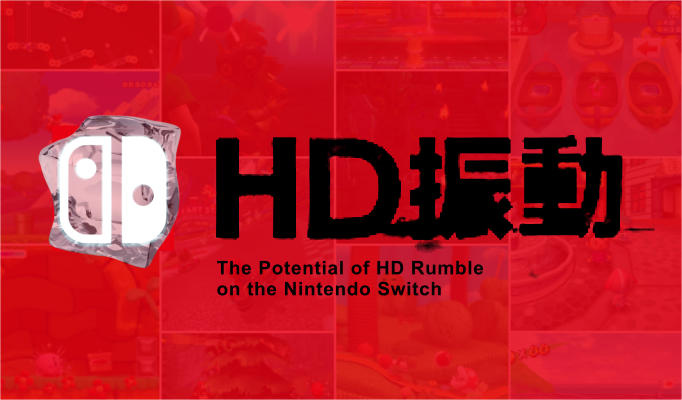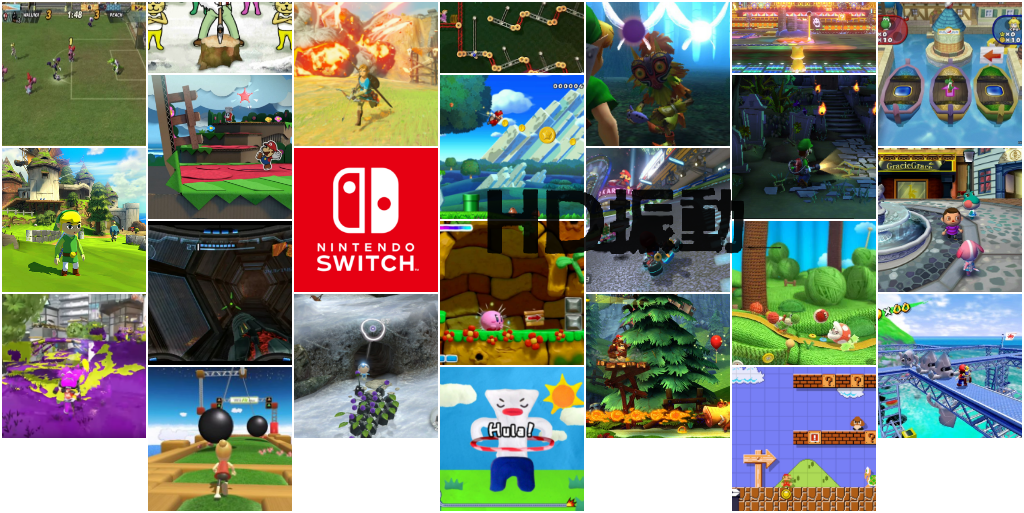

|
Viewout
|
|


In the following of the Nintendo Switch’s big presentation event on January 12 and a bit of disappointment from some due to its higher than they expected price, quite a few user comments could be found who thought that Nintendo better should’ve saved costs by amongst other things not including a new tech with the controllers that Nintendo is calling “HD Rumble” - a new advanced haptic engine that’s allegedly precise enough to mimic the feel of real life objects -, angrily seeing nothing in it than another useless, typically Nintendo, expensive gimmick.
Put short, I really don’t agree with them and don’t think Nintendo shouldn’t have included it.
Although information is of course still scarce at the moment, ahead of the console’s launch, and I’ve not tested it myself, and even though it was hard for me to even evaluate the relevance of just normal rumble, I was immediately convinced by HD rumble during the presentation. As an example, Nintendo claimed in the video that the rumble feedback of the Switch’s so-called Joy-Con controllers would allegedly be good enough to mimic the feel of a glass filled with different numbers of ice cubes and the feel of the glass then being filled with water as well as this all even reacting live and precisely to your motion holding the controller. Perhaps a bit baffled to see this interesting tech really being part of the console and of all Nintendo being the first to make something more meaningful out of it beyond ‘mimicking the feel of an analog button’, I was rather impressed and didn’t saw a gimmick, but in opposite something very innovative that I directly thought could be used greatly for a gaming console.
Later, a mini game was shown to the press to demonstrate the feature, in which the controllers emulate the feel of an unknown number of marbles in a box and the players have to guess how many marbles there are - which is actually even more fascinating and accurate than what I thought it would be capable of. Though, with some of the reporters who played this demo appearing very amazed by it afterwards while others were also pointing out that it was not as good as the newest iPhone-tech from Apple and that they didn’t think it was good enough to really feel like different numbers of marbles, it remains to be seen how powerful it’ll really turn out to be.
What I actually thought of and found interesting when the feature was first shown during the presentation, however, was not its usefulness for marble-counting mini-games, but how it could be used more subtly, like current rumble effects are also most often implemented, to just give a continuous feedback and feel for many actions and things you do in the game and thus be able to create much more extensive atmospheres in games with this new tech.
Like, if there’s ever been a reason for normal rumble effects to enhance the gameplay and begin with certain actions and situations in a game, then it’ll also be an even greater enhancement to for example feel something like a water effect while you’re swimming in a Mario game. Not just some random off-showing water feel, but a slight flow in your hands that would coincide with the speed and movement of the character you’re controlling. That step forward for rumble effects alone instantly appeared really great to me.
There are probably several ways HD Rumble could be utilized and while the Switch’s attraction to casual gamers remains to be seen, a new entry of WarioWare or a Mario Party with many mini-games specifically built around HD rumble can just too easily be imagined, as well as, knowing Nintendo, very likely also many small gameplay mechanics and ideas in other games. And depending on how powerful the tech will really be, it might even lead to a new era and quality of motion controlled games and other stark implementations. But in the long-term, I think HD rumble as a new level of normal rumble effects and to more extensively create ‘atmospheres’ in games could become much more meaningful.
It might be a bit of a surprise to see such a new and high-end technology that was up to now mostly heard from from Apple now being implemented by Nintendo, but thinking about it, HD Rumble actually fits Nintendo very well and makes sense for them in several ways, also beyond what they could do with it gameplay-wise.
The diversity of Nintendo’s IPs could be the perfect match for HD Rumble
The great diversity of their IPs is one of Nintendo’s greatest strengths and HD Rumble would give all those distinct and strong game worlds a new tool to express themselves even more.
Just think about how The Legend of Zelda’s The Wind Waker feels and looks completely different than any other game even in just the same series: Nintendo games much more often create their very own worlds - graphically, musically, with how you interact with them and much more. HD Rumble could become one more important tool for Nintendo to create those extensive and sophisticated game worlds and develop own ‘atmospheres’ for them with distinct ways how everything should feel in them.
Nintendo is also going much more often for more playful and cartoonish worlds instead of trying to create photorealistic copies of our world or variations of it, which is another really great fit for HD rumble. If you’ve got an as human-like and realistic character as possible, his jump on a certain terrain will probably feel very similar to the jump of another realistic character in another realistic game. The feel of a jump in a 2d Mario game therewhile could very likely have nothing in common with the feel of a jump in a Donkey Kong Country game, also on similar terrains.
So having a controller that feels like a realistic car reacting to you pushing down the shoulder trigger like the Xbox One’s does is already very cool, but Nintendo just has a much broader range of things it could try to emulate in games with HD rumble and also this possibility for distinct feels in each game. A more extreme example, you could also compare the idea of what a jump might possibly feel like with HD rumble in a clay Kirby game vs in a fabric Yoshi game vs in a new Paper Mario game. Of course there are also similar special worlds not built around rather realistic human characters elsewhere, but the relevance of such games is just way greater for Nintendo whereas the other platforms greatest titles are most often set in very human worlds.
Personally, I find the thought of continuously feeling the street in Mario Kart combined with the feeling of collecting coins and items and being hit or activating all forms of crazy items makes this much more interesting than the sole idea of realistically emulating the feel of objects alone. Moreover, imagine the idea of the feeling of all the different fighters and their attacks in Smash Bros, or of the different missiles in Metroid, of shooting and swimming through ink in a new Splatoon 3 or the frantic and colorful feel of something like Mario Party also beyond minigames built around HD rumble. Implemented in such ways, it could be kind like a new layer of for example a quarter (perhaps actually a bit less :D) of the relevance of sound in terms of creating the atmosphere in games and able to convey the atmosphere for example also better with sound turned off.
Similar to their stances on graphic quality and raw processing capabilities of their devices, Nintendo might not be interested in creating ever more realistic versions of HD rumble in future consoles or console upgrades, but this basic jump of just rumble to such advanced feels and possibilities might have been what mattered to them when deciding for this tech.
I also think that this is one of the cases in which Nintendo’s special stand as both hardware and software maker in one could be a real advantage. While HD rumble might be some work to implement extensively in a game and generally unattractive for 3rd party developers as it wouldn’t be useful for multi-platform releases, Nintendo, as its own most important developer, can rest assured that if they want and if it’s really good it’ll also be used to great effects and become a core aspect of the console. They’ve created this feature for themselves and their software teams have all resources they need to make what they want out of it and show off HD rumble’s capabilities. And Nintendo has shown several times how much it can make out of a tech like this.
A game that I think could ultimately cumulate a lot of the advantages and aspects I’ve described till here to really great effect could be Animal Crossing. Imagine the feel of hitting a tree with an axe, shoveling or hitting stones, the rain on a rainy day, steps through the different environments and buildings, the feeling while fishing or using the net or the feeling on something like a bus. The game is all about creating an experience. Just doing anything is the game, and not necessarily off-showing effects for all of the things you’re doing, but just a subtle feel for everything all over the game could really add up.
Perhaps this all, especially in conjunction and continuously giving a stream of feedback for most of the things in the game might be too much for what HD Rumble was made to be able for, but it gives a picture of what this all might just be the beginning of and where this tech might lead us.
It’s very easily imaginable how HD rumble might be rather underutilized in the earlier days of the Switch, outside of core games built around it and simple, small implementations, like in Mario Kart 8 Deluxe allegedly feeling from where you got hit when bumping into a car, perhaps also especially with a look at all those ports and other games coming from the Wii U. At a later point, however, when more titles come out whose development began after the console launch and when there’s a more clear image of what all really defines the Switch and are its key features, games could start using HD rumble to a much greater extent and also for this special feeling and atmosphere creation throughout them. Possibly, it could become something of the value of the 3D effect on the 3DS (beside its double life as also a gameplay tool and motion control advancement), pulling the player more into the game experience and rather than being what makes or breaks a game, especially leading also to a general special feel of the console and playing games on it compared to other systems.
With less than a month left until the Switch launches, there’ll soon probably be way more info about how worthwhile HD rumble actually is, as well as chances to try it out oneself, and then we’ll have to wait and see what Nintendo is going to make out of it over the years and whether it’ll become system defining, just a small advancement or quickly forgotten. At least the idea and already shown off capabilities though show a lot of potential and something like HD rumble could truly have great effects for every game and should not be underestimated.
- What do you think about this? Are you excited about HD rumble and the Nintendo Switch and would you be interested in such more extensive experiences through haptic feedback? Or don’t you think that it is that much of an important feature or has such great potential?
